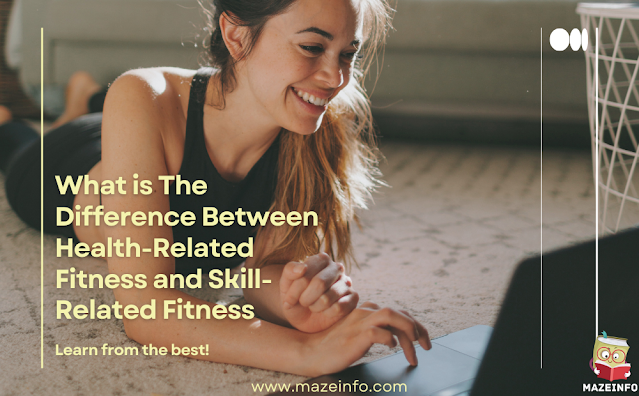In the realm of physical fitness, understanding the distinctions between health-related fitness and skill-related fitness is crucial for anyone striving to achieve overall well-being. These two categories encompass different aspects of physical prowess, each playing a unique role in enhancing and maintaining an individual’s fitness levels. The question that often arises is, “What is the difference between health-related fitness and skill-related fitness?” This inquiry serves as a gateway to unraveling the diverse dimensions of fitness, shedding light on the essential components that contribute to both health and skill-related aspects.
By exploring these disparities, individuals can tailor their fitness regimens to address specific goals, whether they aim for improved health markers or seek to excel in specific physical activities requiring specialized skills. Let’s delve into the intricacies of health-related and skill-related fitness to gain a comprehensive understanding of their distinct roles in the pursuit of a balanced and thriving lifestyle.
Health-Related Fitness and Skill-Related Fitness Define

Health-Related Fitness and Skill-Related Fitness are two distinct components of physical club4 fitness that together contribute to overall well-being and performance. Here are their definitions:
Health-Related Fitness: Understanding the Core Components
Health-related fitness refers to the aspects of physical fitness centers near me that are directly related to maintaining or improving one’s overall health and well-being. These components are essential for preventing diseases, promoting a healthy lifestyle, and enhancing the quality of life. The core components of health-related fitness typically include:
Cardiovascular Endurance: The ability of the heart and lungs to efficiently deliver oxygen and nutrients to the body’s tissues during prolonged physical activity.
Muscular Strength: The maximum force a muscle or group of muscles can exert against resistance.
Muscular Endurance: The ability of muscles to sustain repeated contractions or continue exerting force over an extended period.
Flexibility: The range of motion around a joint, which is crucial for preventing injuries and maintaining mobility.
Body Composition: The proportion of fat and non-fat mass in the body, influencing overall health and fitness.
Focusing on health-related fitness helps individuals achieve and maintain a level of physical well-being that contributes to a healthier and more active and fit lifestyle.
Skill-Related Fitness: Emphasizing Performance and Proficiency
Skill-related fitness pertains to the components of physical fitness that are specifically related to performance in athletic or personal trainer skills activities. These components are crucial for individuals who engage in sports, recreational activities, or professions that require a high level of physical skill. The key components of skill-related fitness include:
Speed: The ability to perform a movement or cover a distance in the shortest possible time.
Power: The combination of strength and speed to generate force rapidly.
Agility: The ability to change direction quickly and efficiently.
Balance: The maintenance of equilibrium, either static (stationary) or dynamic (while moving).
Coordination: The integration of multiple movements or body parts in a smooth and efficient manner.
Reaction Time: The speed with which an individual responds to a stimulus.
Developing skill-related fitness is essential for individuals involved in sports or activities that demand specific motor pure skills fitness and performance capabilities. Improving these components can enhance overall athletic prowess and proficiency in specialized tasks.
Focus

Health-related fitness and skill-related fitness are two key components of overall fitness that contribute to a person’s well-being and performance in various activities. Let’s delve into each of these aspects:
Health-Related Fitness: Prioritizing Overall Well-being
Emphasizing fundamental elements like cardiovascular health, strength, flexibility, body composition, and youfit near me endurance, health-related fitness is the cornerstone of overall well-being. It not only fosters physical health but also contributes to mental well-being, creating a foundation for a balanced lifestyle.
Cardiovascular Health: Engaging in regular aerobic activities, such as brisk walking, running, or cycling, contributes to a healthy cardiovascular system. These exercises improve heart and lung function, enhancing overall endurance and reducing the risk of heart diseases.
Muscular Strength and Endurance: Incorporating strength training exercises into your routine promotes muscular health clubs near me. This includes activities like weightlifting or bodyweight exercises, which not only build strength but also contribute to better posture, joint health, and overall functional fitness.
Skill-Related Fitness: Concentrating on Specific Abilities and Techniques
Focused on specific skillssuch as agility, balance, coordination, power, reaction time, and speed, components of skill-related fitness tailors training to particular activities or sports. This targeted approach allows individuals to excel in their chosen pursuits, whether it’s mastering dance, excelling in sports, or becoming proficient in martial arts. Balancing both health and skill-related fitness ensures a comprehensive and effective fitness regimen.
Agility and Coordination: Activities that focus on agility and coordination, such as agility drills or sports like tennis and badminton, help improve your ability to move quickly and efficiently. These skills fitness are vital for various sports and can enhance overall motor control.
Balance and Flexibility: Incorporating exercises that enhance balance and flexibility, like yoga or tai chi, is crucial for injury prevention crunch fitness memberships and overall well-being. These activities not only improve joint flexibility but also contribute to better posture, reducing the risk of musculoskeletal issues.
Components
It looks like you’ve listed components related to fitness assessment, categorizing them into health-related fitness and skill-related fitness. Let me provide a brief overview of each component:
| Component | Health Fitness | Skill Fitness |
| Cardio Endurance | Oxygen delivery during activity. | Efficiency in specific skills. |
| Muscular Strength | Max force a muscle can generate. | Single-effort force exertion. |
| Muscular Endurance | Repeated muscle contractions. | Sustained muscle activity. |
| Flexibility | Joint range of motion. | Full joint movement capability. |
| Body Composition | Fat-to-lean mass ratio. | Agility, balance, coordination. |
| Agility | Quick, accurate direction change. | Precise body control. |
| Balance | Maintaining equilibrium. | Control in various activities. |
| Coordination | Integrating eye-hand-foot moves. | Smooth, accurate task performance. |
| Power | Rapid force with strength-speed. | Strength-speed synergy. |
| Reaction Time | Stimulus to movement initiation. | Quick response to stimu |
Assessing Health-Related Fitness: A Comprehensive Approach
Health-related fitness is a multifaceted concept encompassing various components that provide insights into an individual’s overall well-being. This holistic assessment includes evaluating cardiovascular health, muscular strength, flexibility, body and fit composition. By examining these key aspects, one gains a comprehensive understanding of an individual’s physical condition and identifies areas that may require attention for the promotion of overall health.
Cardiovascular Health: This component assesses the efficiency of the cardiovascular system, gauging factors such as heart rate, blood pressure, and aerobic capacity. Understanding one’s cardiovascular health fitness clubs near me is crucial for preventing and managing conditions such as heart disease and promoting optimal functioning of the heart and lungs.
Muscular Strength and Flexibility: Evaluating muscular strength and flexibility provides insights into the body’s ability to perform everyday tasks and withstand physical stress. A balanced assessment helps in designing targeted exercise routines to enhance strength, flexibility, and overall musculoskeletal health.
Body Composition: This component focuses on the proportion of body fat to lean body mass, offering valuable insights into an individual’s overall healthy pre workout status. Maintaining a healthy body composition is essential for preventing obesity-related health issues and optimizing physical performance.
Exploring Skill-Related Fitness: Beyond the Basics
Skill-related fitness delves into the more nuanced aspects of physical well-being, encompassing agility, balance, coordination, power, reaction time, speed, and skill components fitness mastery. This set of components goes beyond the fundamentals, providing a more detailed assessment of an individual’s athletic prowess and functional abilities.
Agility and Coordination: Agility and coordination are crucial for activities that require quick and precise movements. Assessing these skills fitness center helps identify areas for improvement and tailor training programs to enhance an individual’s ability to move with speed and precision.
Balance and Power: Evaluating balance and power is essential for activities that demand stability and explosive strength. A comprehensive assessment ensures a well-rounded approach to fitness, focusing on both static and dynamic components of physical performance.
Reaction Time and Speed: Reaction time and speed are critical for various sports and daily activities. Assessing these components aids in identifying areas for improvement and tailoring training programs to enhance an individual’s responsiveness and quickness.
Skill Mastery: The mastery of specific skills related components to sports or physical activities is a key component of overall fitness. Evaluating skill mastery provides insights into an individual’s proficiency in executing specific movements, helping design targeted training programs for skill enhancement.
Purpose
.png)
Physical fitness serves dual purposes, encompassing both health-related and skill-related dimensions. These dimensions are crucial in fostering holistic well-being and performance excellence.
Health-Related Fitness: Enhancing General Health and Preventing Diseases
Health-related fitness is centered on promoting overall well-being and mitigating the risk of diseases. This facet of sunny health and fitness treadmill involves activities aimed at improving cardiovascular health, muscular strength, flexibility, and body composition. Engaging in regular physical exercise not only boosts the efficiency of the heart and lungs but also strengthens muscles and enhances joint flexibility. Additionally, stomach fat workout it plays a pivotal role in maintaining a healthy body weight and composition, reducing the likelihood of chronic conditions such as heart disease, diabetes, and obesity. Prioritizing health-related fitness contributes to the development of a robust immune system, ensuring the body’s resilience against various illnesses.
Skill-Related Fitness: Improving Athletic Performance and Specific Skill Proficiency
Complementary to health-related fitness, skill-related fitness is geared towards refining specific abilities essential for athletic endeavors and specialized tasks. This dimension encompasses components such as agility, speed, coordination, power, physical trainer and balance. Athletes and individuals pursuing proficiency in particular skills benefit significantly from targeted training regimens. Enhancing skill-related fitness not only optimizes athletic performance but also refines the precision and efficiency with which specific tasks are executed. Whether it be honing agility for a sport or refining dexterity for a profession, the focus on skill-related fitness is instrumental in achieving mastery and excellence in a chosen field.
Time, Speed, and Skill Mastery
Time, speed, and skill mastery form the nexus where health-related and skill-related fitness intersect. Efficiently managing time and incorporating speed into physical activities is pivotal for optimizing workouts and achieving desired results. Additionally, skill mastery is an ongoing process that requires consistent practice silversneakers and refinement. Whether it involves perfecting a golf swing, mastering a dance routine, or excelling in a particular sport, the amalgamation of time, speed, and skill mastery is emblematic of a holistic approach to valley fitness. By embracing these interconnected elements, individuals can cultivate a balanced fitness regimen that not only enhances their general health but also propels them towards peak performance in their chosen pursuits.
Also, Read More: How to Make Outdoor Hook and Ring Game?
Applicability
The concept of health-related fitness and skill-related fitness is often used in the context of physical fitness your way and exercise. Let’s explore the applicability of each to different populations:
Health-Related Fitness
Relevant for Individuals of All Ages: Health-related fitness components include cardiovascular endurance, muscular strength, muscular endurance, flexibility, weight lifting weights and body composition. These components are important for people of all ages to maintain overall health and well-being.
Fitness Levels: It is applicable to individuals at various fitness levels, from sedentary individuals looking to improve their health to those already engaged in regular physical activity. The emphasis is on promoting general health clubs and reducing the risk of chronic diseases.
Skill-Related Fitness
Particularly Significant for Athletes: Skill-related fitness components include agility, balance, coordination, power, reaction time, lose weight by walking and speed. These components are crucial for athletes and individuals involved in specific sports or activities that require a high level of performance in these areas.
Specific Physical Activities: Skill-related fitness is especially relevant for those engaged in activities that demand specialized skills. Athletes, dancers, martial artists, any fitness and individuals participating in sports such as soccer, basketball, or gymnastics benefit from honing these skills to enhance their performance.
Training Approach

To create a comprehensive training approach that addresses both health-related fitness and skill-related fitness, active & fit it’s essential to design a program that integrates various components. Here’s a breakdown of how you can approach each aspect:
Health-Related Fitness
Cardiorespiratory Endurance
- Include aerobic exercises like running, cycling, or swimming.
- Aim for at least 150 minutes of moderate-intensity or 75 minutes of vigorous-intensity cardio per week.
Muscular Strength and Endurance
- Incorporate resistance training with a focus on major muscle groups.
- Include exercises like weightlifting, bodyweight exercises, and resistance band workouts.
Flexibility
- Integrate dynamic stretches before workouts and static stretches after.
- Include activities like yoga or Pilates to enhance flexibility.
Body Composition
- Combine a balanced diet with a calorie-burning exercise routine.
- Monitor and adjust nutrition based on fitness and health goals.
Recovery and Stress Management
- Include rest days to allow muscles to recover.
- Incorporate stress-reducing activities like meditation and adequate sleep.
Skill-Related Fitness
Agility
- Integrate agility drills specific to the sport or skill.
- Use cone drills, ladder drills, and sport-specific movements.
Balance
- Include exercises that challenge balance, such as single-leg movements.
- Utilize stability exercises with tools like balance boards or stability balls.
Coordination
- Incorporate activities that enhance hand-eye coordination or specific sport-related movements.
- Include drills that mimic the coordination requirements of the chosen activity.
Power
- Integrate explosive exercises like plyometrics.
- Incorporate Olympic lifts or medicine ball exercises to improve power.
Speed
- Include speed drills tailored to the specific sport or skill.
- Implement interval training and sprints.
Measurement
Measurement of fitness involves assessing various components, including both health-related fitness and sunny treadmill skill-related fitness. Here’s a breakdown of how each type of fitness is typically measured:
Health-Related Fitness Measurement: Standardized Tests and Health Assessments
Understanding an individual’s health-related fitness involves employing standardized tests and health assessments. These assessments, such as measuring resting heart rate, blood pressure, muscle and fitness flexibility exercises, provide quantitative data on cardiovascular health, muscular fitness, and body composition. The results serve as a foundation for designing personalized fitness programs and monitoring overall health.
Skill-Related Fitness Assessment: Performance in Specific Skills and Activities
Skill-related fitness focuses on an individual’s proficiency in specific tasks and activities, evaluating motor skills, agility, balance, coordination, power, weight training and reaction time. Unlike quantitative measurements, this assessment involves observing and analyzing performance in designated activities. For athletes and enthusiasts, skill-related fitness assessments guide personalized training programs, enhancing specific skills essential to their chosen pursuits.
Conclusion
While health-related fitness focuses on components essential for overall health workout to lose belly fat and disease prevention, skill-related fitness targets specific abilities crucial for optimal performance in sports and other physical activities. Both aspects contribute to a well-rounded approach to fitness, ensuring individuals can lead healthy lives and excel in activities that require specialized physical skills. Balancing these components can lead to a comprehensive you fit gym and holistic approach to personal fitness.
Frequently Asked Questions
Q: What is health-related fitness?
Ans: Health-related fitness refers to the components of physical fitness that are directly related to one’s overall health and well-being. It includes aspects such as cardiovascular endurance, muscular strength, muscular endurance, flexibility, and body composition.
Q: What is skill-related fitness?
Ans: Skill-related fitness pertains to the components of physical fitness that contribute to one’s ability to excel in sports or specific physical activities. These components include agility, balance, coordination, power, reaction time, and speed.
How do health-related and skill-related fitness differ?
Ans: Health-related fitness focuses on fundamental aspects essential for overall health, while skill-related fitness emphasizes specific attributes that enhance performance in particular activities or sports.
Q: Why is health-related fitness important?
Ans: Skill-related fitness is vital for individuals engaged in sports or specific physical activities. It enhances performance, agility, and overall proficiency in tasks requiring specialized physical abilities.
Q: Can one type of fitness be prioritized over the other?
Ans: Both health-related and skill-related fitness are important, and their significance depends on individual goals. For a well-rounded approach to fitness, it is recommended to incorporate elements from both categories into a balanced exercise routine.



